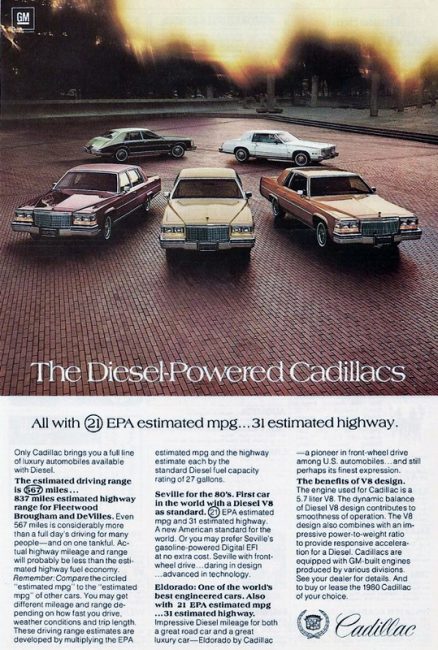
Oldsmobile was the pioneer in engineering GM’s Diesel V8. The engine was also available for the Cadillac Seville in 1978, and for the Eldorado, Fleetwood Brougham, Coupe deVille and Sedan deVille in 1979.
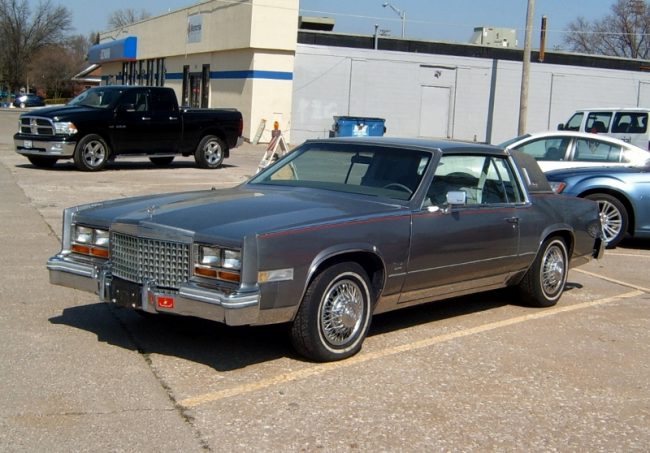
Despite many horror stories over the years, the much-maligned 5.7 Diesel, when properly maintained, could be reliable. However, many of the buyers of GM cars fitted with this engine were quite unfamiliar with the additional care and feeding diesel engines required vis a vis the gasoline V8s many of them traded off for one of these. As a result, many of them experienced headaches from their cars. The whole GM Diesel V8 episode turned many Americans off to Diesel engines for years. Though by 1982 they had been reengineered and as a whole were much less needy. But by them it was too late; people were staying away.
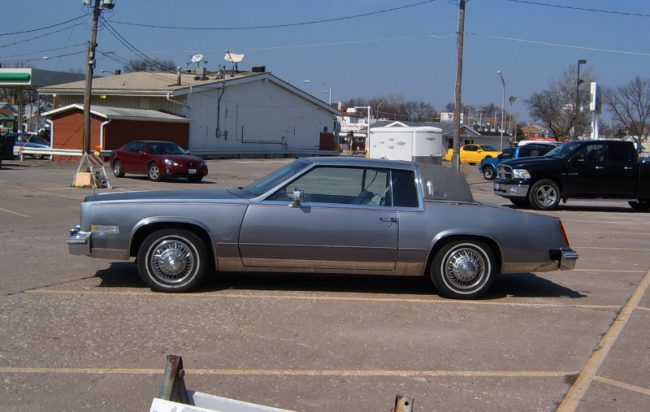
Ah, but what of the newly-downsized Eldo? Well, in a word, it just worked. It lost none of the imposing presence of its larger predecessors. And if the “plain” Eldorado didn’t do it for you, you could always move up to the über-flashy Biarritz.
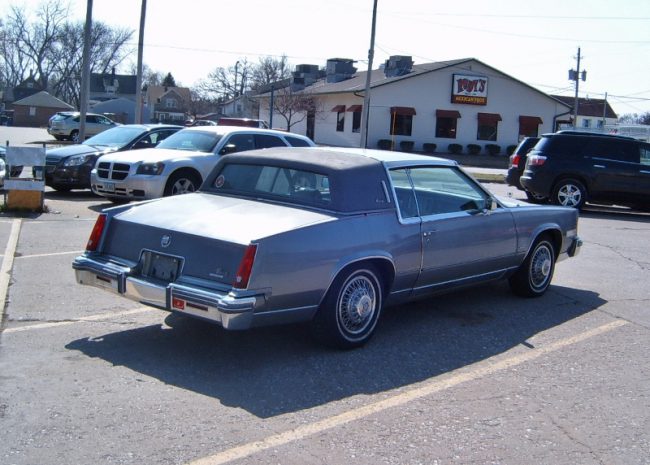
Yes, the Biarritz had every luxury feature your heart could possibly desire: button-tufted leather (White with red carpet? No problem!), a stainless-steel roof cap, a landau vinyl roof, coach lamps, and your choice of wire wheel covers or aluminum road wheels–with whitewall tires, of course.

Among the very few changes made for 1980 were a restyled, more vertically-oriented grille–and behind it, a new, Caddy-only 368 that succeeded Oldsmobile’s gasoline-fueled 350 V8 that Eldorados carried in 1979. Here is the ’80 Eldo, from that year’s brochure, looking quite natty in Colonial Yellow. I have always had a thing for Cadillacs in this color, with the matching pale-yellow leather. Perfection!
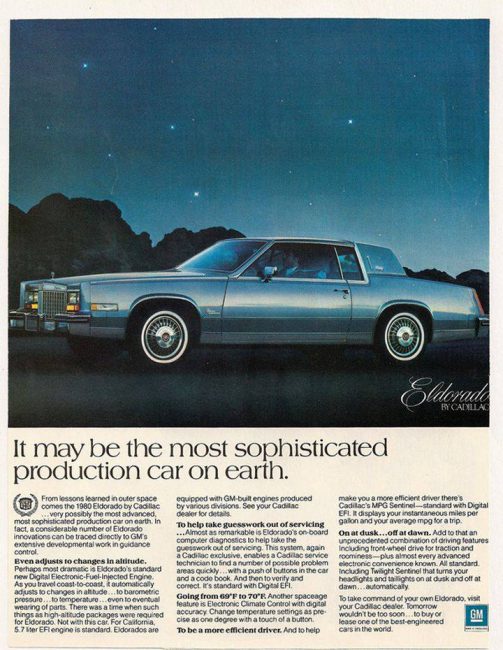
I saw this rare birdie back in March of 2012 in uptown Moline, IL. The car I spotted was not quite as brilliantly hued as some of the amazing colors available on 1980 Cadillacs, but it was still attractive in Sheffield Gray Firemist, an extra-cost color. It had a matching top, red pinstriping and dove gray leather interior. Subtle, but an elegant combination.
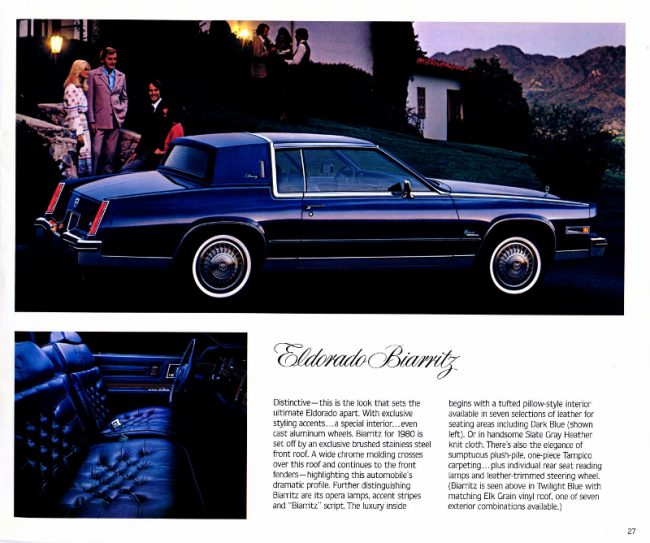
I really like the aluminum wheels that were available on these, but it seems like at least 90% got the wire wheel covers instead. Which is a shame.
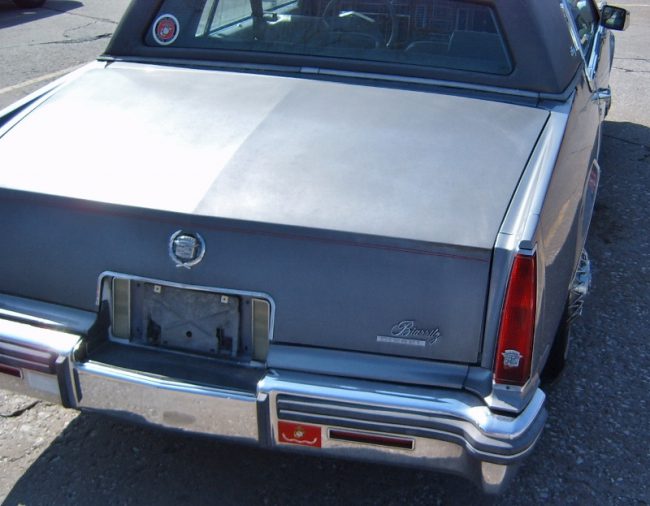
While weathered, overall, this car was in pretty solid shape. Sure, there was a little rust. The paint was sunburned somewhat on the hood, roof and trunk lid, but all the little chrome trim bits were there, the chrome bumpers shone brightly, and all four wire wheel discs and all four whitewall tires were present and accounted for.
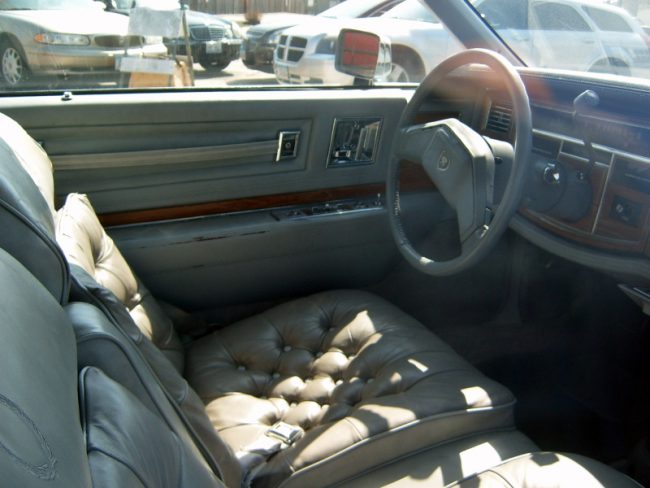
The interior is also restrained–at least as much as is possible on a button-tufted Biarritz–with Light Antique Gray leather. Look at all that soft leather. Cadillac really knew how to do plush seating back then.

Still classy in 2019. I last saw this car parked in Silvis, around 2013. I wonder if it’s still on the road today?

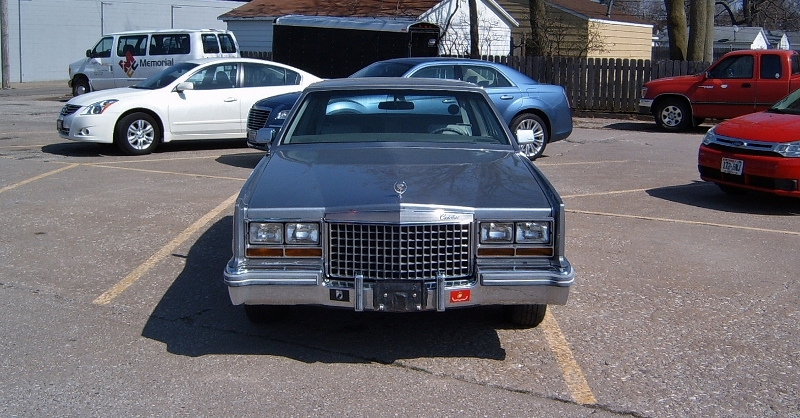






19 Comments
I don’t know about the reliability of these diesels (I’ve heard varying stories over the years), but 105hp/205lb-ft is not a very high output for this type of car.
I get that apparently all the decision-making overlords in 1980 thought the world would be out of petroleum by 1985 and that consumers were spending ridiculous sums on a 77hp diesel Mercedes. But still, I’m getting a 368 in my Cadillac. Especially if I think the world is going to end.
Oh yeah, the 368 is the way to go. I’ve never gotten into the whole diesel thing, GM or otherwise.
The diesel wasn’t nearly as damaging to Cadillac’s brand as the V8-6-4 was.
My 81 CDV was an 8-6-4, it worked flawlessly.
105 hp/205 lb-ft is about what I got from my ’84 Cougar with the 3.8 V6, a very nice engine if you could keep it from munching on its head gaskets.
The in-laws had a diesel Olds — Delta 88, I think — and it returned close to 30 mpg on the road from Central Time to Epcot Center. It wasn’t quite as lush as the Cadillacs of the day, but it was pleasingly Broughamy.
My favorite of the diesel Caddys was the 85 FWD Coupe de Ville with the 4.3 V6 cutdown of the V8. The sensible size would have pushed highway mileage into the mid 30s with the long range of an 18 gallon tank. Seems like the perfect eighties car for an American to take around the world. That journey requires a diesel because most places then lacked unleaded. The name would have been familiar but the size and shape not, enhancing safety. The sadist words are, it might have been.
Few people remember that Olds had a few experiemental gasoline motors that were 14.5:1 compression ratio (and in some cases higher) that utilized the stock block. Diesel typically used a 17:1 compression ratio, the Olds block could handle the stress. Many first time Diesel owners didn’t have a clue and were either unable or unwilling to care for the motor properly. Even in the late 1970’s, gasoline engines were pretty decent and if nothing else, had a huge body of knowledge on how to keep one running, even among the mechanically-reclined.
My dad drove a truck back in his working days; I have a love/hate affair with Diesel odors. But even as a lanky teen, I knew that the vast majority of people who were getting into a Diesel car for the first time had no clue. FWIW, when in I was in Germany in the late 70’s, those Oldsmobile Diesels had a great reputation. They were quite expensive, but the folks who owned them, loved them. The 1982 rework made the motor and it’s systems more “user-friendly”, but we all know what had happened.
In the aftermath of VWs Diesel-gate, I think the Diesel motor is permanently dead in first world nations. Electric car mandates and their eventual development to where they can subsume many of the capabilities of ICE powered cars, will be final nail in the coffin. I wonder what the landscape for the Diesel would have been in this part of North America had the GM experience been better.
The Oldsmobile diesel had a compression ratio of 22.5:1 while maintaining the 10-bolt head mounting pattern of the gas V8s to use common tooling. The resulting head gasket and head bolt failures were not the result of deficient maintenance. The lack of a water-separator for the fuel system wasn’t the fault of user error either.
I don’t have any direct experience with the 5.7 V8 or the V6 diesel, but I was a Motor Transport Officer (Motor T) in the UCMC from 89-93, and had many M998 HMMVWs (Humvees) in the motor pools. The Humvees, built by AM General, had the 6.2L V8 GM diesels. The CUCVs (Cargo Utility Commercial Vehicle), Chevy pickups, had the GM diesel, although I don’t remember if they were the 6.2 or the 5.7, probably 6.2.
As far as the Humvee went, we were forever replacing glow plugs, broken alternator brackets, and torn CV boots. Because they burned diesel, along with our 5 tons trucks and OshKosh Dragon Wagons, only one type of fuel was needed. No mogas required. Most of our Humvees had the deep water fording equipment, including the air intake snorkels and the high exhaust stacks. The air intake snorkels also turned out to be useful in the Gulf War. They sucked in less dust than the standard intake down at engine level.
Back in ’82 when I was in high school, my uncle bought a Chevy Suburban with a GM diesel, I think the 6.2, but it could have been the 5.7. He and my aunt drove it for at least 10 years and finally went back to gasoline for his next Suburban. He pulled a camper, large enough for them and 4 kids. As far as I know, he had good service from it.
I meant HMMWVs, not HMMVWs.
Tom,
Eldorado…glad you’re back!
Ah, the Olds Diesel Debacle. There were many Deadly SIns committed in that era – from Rapid-Oxidation Vegas, to the THC400 winding up in full-size cars, overloaded, undertested, and leaving owners’ finances hanging in the wind.
If it were one product, or a coherent progression of them, I’d blame larcenous intent. But, with time, frankly I’m left to conclude: GM, in the fast-changing era of hyper-regulation, tort culpability, engineering hindsight by the media…they were overwhelmed.
Of course much of it was their own doing. GM was the one who engineered the Annual Model Change – automobiles as a fashion statement. That reached the height of ridiculousness in the 1950s…remember the batwing Chevrolet and similar bretheren of that era? I sure do. When I was a wee lad, they were about five years old, rusting madly…and compared to the crisp 1964 Chevrolet, they looked dated and silly.
They weren’t even very good at what they did – the A-post dogleg was good for whacking kneecaps. The wipers opened peepholes on that immense, contorted windshield. The French curves of the rear were great for trapping water, road salt, and converting it to sheets of loosening, flapping body steel.
With smog and safety and other regs arriving in 1968, even great big GM could no longer afford to play. And they did tone down the model-changes; but they continued to try to be all things to all buyers. The diesel was a case in point.
GM was obvously not intrinsically sold on diesels. They just saw much of their customer base go to M-B, and saw that diesels gave somewhat better economy. No one knew what the coming Silicon-Chip Revolution would do to gasoline car mileage. So, GM obliged to follow the Diesel March – and as with so much else they began at the parts bin.
And all it takes, with so many disasters, is just one or two missteps. Here we have inadequate cylinder-head fastening, coupled with inadequate dealer training. The result was one MORE epic marketing failure for GM. Wheras, a little more testing, a little more training, and a lot more consideration for buyers and attempts to make it right, might have made lemonade out of this lemon.
Bottom line is, they did not have the resources to do this, at least as fast as they tried, and they lacked the self-examination to know what they did not know.
Interesting how a pretty straightforward conversion of a gas engine to diesel brings forth such vitriol, at least when GM does it. VW when they do it to the Rabbit engine. Wow, that’s just great, and if the cheap hippy goes through 3 junk yard engines in his quest for 200k miles, excuse me kilometers, well that just shows the love. Well what about when they put it in bizarrely heavy for it Vanagons, I mean that’s a safety issue right? No of course not. those are the holy grail, they get extra pot brownie points at all the I’m grateful their dead concerts. BMW, when they did it to their inline 6, what a great idea to fix their gas hogness, that we otherwise don’t admit. Toyota when they did it to their Camry engine? Well frankly I had forgotten those, but the Camry engine was a farm out to Yamaha in the first place so if the diesel was half baked, it’s only fair to blame them. British Leyland when they did it to their B series MGB engine. No that sounds crazy, thanks I was looking at something else with them to complain about.
“nteresting how a pretty straightforward conversion of a gas engine to diesel brings forth such vitriol, at least when GM does it.”
Maybe because…wait for it…
IT DID NOT WORK.
People buy cars for transportation. Not to Virtue-Signal. Volkswagen, in that era, did the diesel, obviously, FAR better than Goober Motors.
“people buy cars for transportation, not to virtue signal”
Don’t let that idea get out to the VW diesel people
Virtue-Signalling was unheard of, in the era of the Olds Diesel.
The nascent neo-Marxist movement hadn’t yet been able to politicize things like auto choices or diet.
Cars in those days stood on their own merits – depending on how they were sold. They were fashion statements or technological wonders; but the Olds was a testament to engineering cynicism and the fruits of mindless cost-cutting.
The VW Diesel did what it was supposed to do. Very slowly, with 47hp, but in the era of the 55-mph-speed limit (one of the Left’s first attempts to hamper travel and make it inconveninent) that low horsepower output was acceptable.
Volkswagen GREW in those years. Olds diesels only did for the first few, until they started failing in large numbers.
When was the last time you saw a VW converted FROM diesel TO gasoline? Because that was the fate of many, many two- and three-year-old GM cars with those diesels.
Of course people in the seventies signaled their politics with their car selection. Everything boomers did was political and those on the left specifically wanted to jab at their parents whom they so resented. Notice the 70s import boom was only for the old axis powers, even when cars like the Rabbit and the Mazdas were so unreliable and the Japanese like the B210 the Subaru, and the Corolla 1200 were just pathetic short lived penalty boxes that were as incapable of interstate travel as the 1960s Renaults, while lacking their comfort.
Bad Olds diesels or not, diesel died, or at least went into a coma after 1982, even all those other “smart car companies that are not dumb GM” really couldn’t make a go of diesel after gas prices stabilized and then went down in the early 80’s. Mazda, BMW even the holy of holiest, Toyota, really couldn’t gain any traction with their diesels and dropped all their diesel options by 1985-1986.
i have a cadillac de ville 1980 colonial yelow import u.s.a. all doco first owner Hartenstein cant find him
for the moment motor broken after 4 years i found a engin running but stil not finisch resto need info vacoom and electric need help!